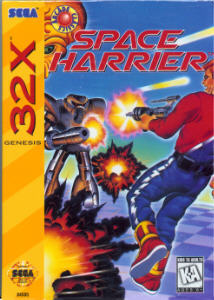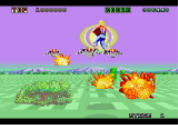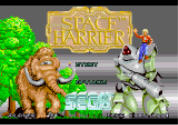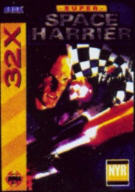 |
| Title: | Space Harrier |
| Released: | 1994 |
| Genre: | 2-D Shooter |
| Developer: | Sega |
| Publisher: | Sega |
| Regions: | USA, UK, Japan |
| Availability: | Common |
|
|
Also known as Super Space Harrier.
Sega’s Space Harrier inhabits a special place in my video game consciousness, and I can still remember the first time I laid eyes on it many years ago. I was walking around the Putt-Putt Golf and Games, making the rounds in the arcade and checking out the new titles. I had pretty much finished my tour of the arcade floor and had returned to the entrance when I suddenly turned around and came face to face with Space Harrier. It had been standing near the front door, the place reserved for the arcade's premier (50 cents!) titles. I was immediately awe-struck by the game's incredible graphics and psychedelic vibe. Now, thanks to the unstoppable march of technological advances, you too can play an almost arcade-perfect version of the game that left me dumbfounded so many years ago.
Space Harrier appeared in arcades in 1985 and was one of the titles that first earned Sega its well deserved reputation as a premier arcade game developer. Arcades that had grown accustomed to the flat worlds of Defender and Asteroids were suddenly thrust into the bizarre and colorful 3-D universe that is Space Harrier. Never before had graphics been so rich, or come at you so fast and smooth. I couldn't wait to get my hands on a home version. I would have to wait a while for a good one since none of the home consoles of that time (Atari 2600 and 5200, Intellivision, or Colecovision) could handle the complex graphics.
The first home translation of Space Harrier appeared as a premiere title on Sega’s fledgling Master System console. The Master System was advertised as an arcade experience at home, but many of the SMS’s arcade translations were mere shadows of their arcade parents. This first home Space Harrier, while certainly playable and fun, just wasn't as good as the original; the Master System's limited color palate left the game looking washed out, while the trademark voice was suspiciously less chatty. The graphics were rather sparse and grainy and moved around the screen in great big blocks of flickering data. Space Harrier was also produced for the 8-bit Famicom (Nintendo Entertainment System in the states), but it never made it out of Japan and probably wasn't much better than the Master System effort.
The 16-bit era was much kinder to Space Harrier. The TurboGrafx-16 was home to a very respectable version, though still not as good as the arcade. The Genesis skipped the original and produced an enjoyable sequel aptly titled Space Harrier II, based on the extremely obscure arcade game. Unfortunately, home gamers were still without a really good version of the original Space Harrier.
The 32X version of Space Harrier, along with After Burner, debuted in 1994 as part of the second wave of first-generation titles released for the system. Both games demonstrated that the 32X was capable of good arcade ports, though critics pointed out that they were a bit dated by that point and were perhaps not the best choices for a fledgling system in need of high profile titles. Whatever the case, Space Harrier32X is nearly arcade-perfect and is itself virtually identical to the version that appeared on the Sega Ages compilation for the Saturn (which also included Outrun and After Burner II). Despite its rather limited game play and dated feel, Space Harrier is a shining example of Sega’s arcade brilliance and a worthy edition to any 32X library.
Space Harrier is basically a simple shooting game set in a pseudo 3-D world and is a game with its own very unique graphical style, perhaps best described as the video game equivalent of a groovy psychedelic acid trip. You control a little flying man instead of the normal aircraft or spaceship, and you are armed with a simple energy pulse weapon. Like many shooting games, the world of Space Harrier is populated by a variety of extremely odd creatures obsessed with your destruction. The game is divided up into sections, with each section having its own assortment of enemies and environmental features. The flying, segmented dragon-centipede creature at the end of round one is merely the first in a series of extremely imaginative “boss” creatures that you will come upon at the end of each wave. Space Harrier is the epitome of simplicity and only uses the direction pad and a single firing button. This is refreshing in an age where more and more video games utilize every single button on the joystick (eight on the Playstation One, not counting pause and start). Super-precise control isn't necessarily bad, mind you, but its just kind of nice to pick up a game that is so straightforward and direct. You have the option of choosing between standard control (pressing up goes up, pressing down goes down) or the common “jet fighter” control structure where pressing up point moves you downward and vise-versa; either way is fine and is completely dependent on your personal preference. The firing of your one and only non-upgradable energy weapon is accomplished by pressing any one of several redundant buttons. You may only hold down a button for continuous fire, but rapidly pressing the fire button releases more shots than simply holding down a fire button. Directional control is fast and accurate, just like the arcade. The only control flaw seems to take place when your character is on the ground (you have the option of running on the ground instead of flying). While running is rarely advisable and not really used much, the fact that the control is a bit off and the collision detection a bit suspect just detracts from an otherwise arcade-perfect experience. Otherwise, control and maneuverability are top-notch.
Bizarre graphic imagery has always been a defining characteristic of Space Harrier, and the 32X version does not disappoint. The cartoonish colors are bright and vibrant, with none of the washed-out appearance that plagued earlier versions. The graphics are nearly arcade-perfect, with very smooth scaling and a mostly constant frame rate. Space Harrier was one of the pioneers of videogame "boss" characters, and the flying segmented dragon at the end of level one remains one of the coolest and most-recognized boss characters in the history of gaming. All of the levels and bosses are faithfully duplicated, down to the bonus stages featuring another flying dragon that you get to ride (shades of Panzer Dragoon?) in an effort to collect bonus points. The only real detraction is the fuzzy video output inherent of the Genesis, compounded by the less-than-perfect video connections many of us have on our televisions.
The 32x isn't famous for its stunningly clear sound capabilities, but it does a fine job emulating the arcade's distinctive speech, music, and special effects. The funky little keyboard tunes are fully intact, as are the musical changes that occur right before each showdown with a boss character.
Space Harrier
is still a shining example of Sega's incredible arcade heritage, even nearly
20 years after its release. The 32x port finally does justice to this classic
game, certainly one of the defining milestones in the shooter genre. Space
Harrier is a fairly common 32x title and not difficult to locate,
so you have no excuse for its absence in your collection.



 |
 |
|
|
|
 |
The Sega Master System didn't have a huge library of games (in the States, at least, though it was much more successful in Europe and South America) but it did have some decent arcade ports. Space Harrier made its first appearance on the Master System way back in 1988 and was one of its biggest sellers. Not bad, but definitely 8-bit. |
 |
The Master System was home to the Sega 3-D glasses, one of the coolest peripherals ever produced for any console. Space Harrier 3-D does a decent job of utilizing the glasses, and is actually quite a bit different from the regular version, sporting different levels and new enemies. |
 |
The Nintendo Famicom (short for Family Computer) uses the same hardware as our NES (short for Nintendo Entertainment System). The Famicom port of Space Harrier is rumored to be much like the Sega Master System release, but it never made it out of Japan. Let us know if you can provide us with a scan of the box! |
 |
The tiny Turbo Grafx-16 HuCard actually delivers a fairly accurate port of Space Harrier. The graphics aren't quite as large and detailed, but the sound and speed are terrific. Even more fun to play on the TurboExpress where the graphics really shine on the tiny active-matrix screen. |
 |
Space Harrier II actually began as an arcade sequel that few people have heard about and even fewer have played. The Genesis port sports early 16-bit graphics, interesting levels and bosses, and a high degree of speed. So why didn't Sega give us Space Harrier III for the 32x instead of the original? |
 |
Looking and playing very much like the Master System original (not surprising as they share closely-related hardware), Space Harrier for the Game Gear has fewer levels and the crappy sound typical of many handhelds. Let us know if you can provide us with a scan of the box! |
 |
Back in the early days of gaming, popular arcade games generally didn't stay console-bound for long. Space Harrier appeared on numerous computer platforms, including the Commodore 64, IBM PC, Amstrad, and even the Sinclair Spectrum. Most computer ports share similar packaging, but differ wildly in regards to the accuracy of the translation. |
 |
The Sega Saturn compilation CD Sega Ages contains an arcade-perfect port of Space Harrier, along with After Burner II and Outrun. How we would have loved to see a 32x port of Outrun, our favorite racing game of all time! |